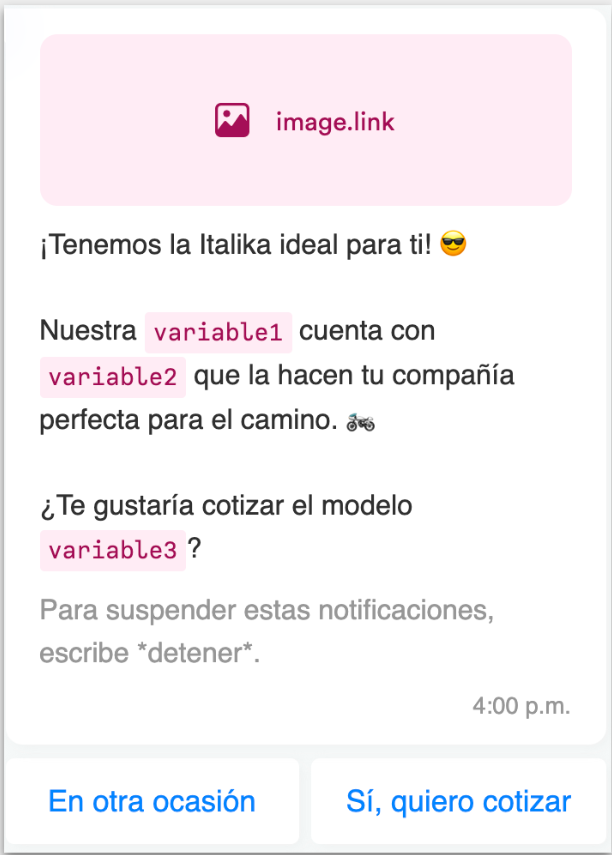Best practices for Creating WhatsApp Templates
Structure and Format
Categories
WhatsApp has several categories to classify the notifications you upload to the platform. It is essential that you choose the most appropriate for your messages to reduce the probability of rejection.
Yalo has the following type of campaigns categories:
-Promotional: Any profile can get an audience and send these types of notifications from Engagement/Studio.
-Transactional: Requires a developer to connect/create an endpoint.
-Product: Any profile can get an audience and send these types of notifications from Engagement/Studio.
-IVR: Requires a developer to connect/create an endpoint.
-OTP (One time password): Requires a developer to connect/create an endpoint.
These are the types of campaigns by Uses Cases:
- Releases
- Promotional Campaigns
- Special Holidays
- Data update
- Order status
- Filling of forms
- Customer Operational Notices
- Movement alert
- Delivery of account statements, collection
- Order reminder
- Surveys on the product/service
- Onboarding / Welcome to the channel
- CSAT
- New features
Notification Design
When creating a new notification template, consider:
- What is the objective?
- Who are the users that will receive the notification?
- What does the client expect their users to do?
- How does the notification benefit users?
- Which are the KPI's for the notification?
Notifications Specs
A Notification has the following formatting requirements:
- 1.91:1 structure
- 800 x 410 PX
- 72dpi and .jpg
- 500 KB
- Optimized for web high quality (80%)
- Without bullets or “promo discounts visible”
Parameters for variable information:
-Some words can re-use: Usernames, promo dates, product, prize, banned words, etc.
-Some words we can’t say: Promotion, sale, discount, credit, credit card, etc.

Sample notification with Call to Action (CTA)
Naming Convention
An intuitive name helps bring clarity to its purpose. It can also help you and your team by keeping a more controlled record of the campaigns sent.
WhatsApp has some tips for naming them and speeding up their approval.
- Use alphanumeric and lowercase characters
- Take advantage of underscores to separate words or numbers
- The more descriptive the name, the better.
Eg: "fathers_day_01", ”Buen_fin_2020”
Formats for content
Character limit
The maximum allowed is 1,024 characters.
Style
Text can be stylized in various ways using special characters.
- For bold insert an asterisk (*) at each end of the text you want to highlight
- for italics insert an underscore () at each end of the text
- for a text ~~ traversed ~~ insert an equivalence sign (~) also at each end
Variable parameters
They are information within the text that can be replaced . On one hand, they help the user experience be closer and friendlier. On the other hand, they are an advantage when handling very large databases.
They are expressed with a number within 2 brackets: {{1}}
| How the template looks | What the user receives |
|---|---|
| Hello {{1}}! Remember that your payment deadline is {{2}}. | Hello, Julia! Remember that your payment deadline is May 15. |
2. Message approval
WhatsApp has a very strict shipping policy. It is very important to take the following points into consideration before uploading a message for approval:
- It contains relevant information for the user and is not promotional
- Includes 2 parameters, or in some cases, a maximum of 3
- It has no spelling or syntax errors
- The notification name is clear and descriptive
- Has no content that is offensive or violent
More recommendations
Emojis
Emojis are a tool that you can take advantage of in 2 ways:
- Help the user locate relevant information.
Eg: Log in here 👉🏼 [www.tiendaonline.com/login] (http://pdf.tiendaonline.com/login)
- Emphasize the emotion you want to communicate and generate empathy with the user.
Eg: Congratulations José! 🥳 You have approved credit. 🎊
It may sound easy, but it is essential that emojis are used only when they have a clear purpose. Otherwise, they could be interpreted as signs of mockery, lack of commitment, etc.
Call-to-Action
Finally, we have the Call-to-Action (CTAs). They are words or phrases that help keep the communication channels open with the user, inviting them to perform an action to keep them engaged. Every notification we send is an opportunity to start a conversation and perhaps close a sale.
They must be attractive to the user and not an obligation that they must fulfill.
Eg: Maria ... what do you think? We already have the products you expected. Type wow to see them. ** 🤩
CTAs should be placed at the end of the message.
Updated about 2 years ago
